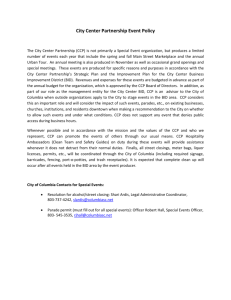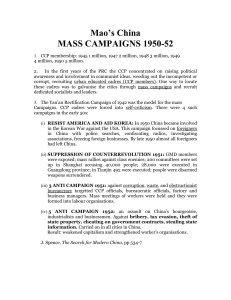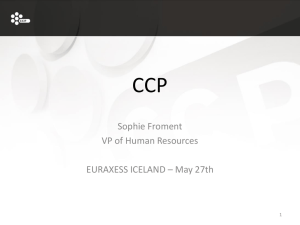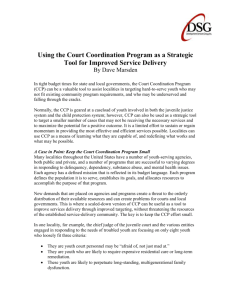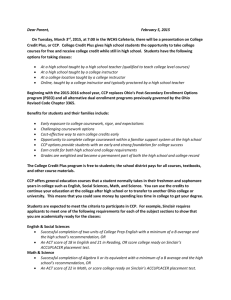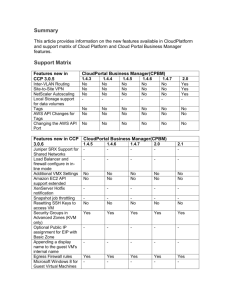Pleadings_Byrne - PPT
advertisement
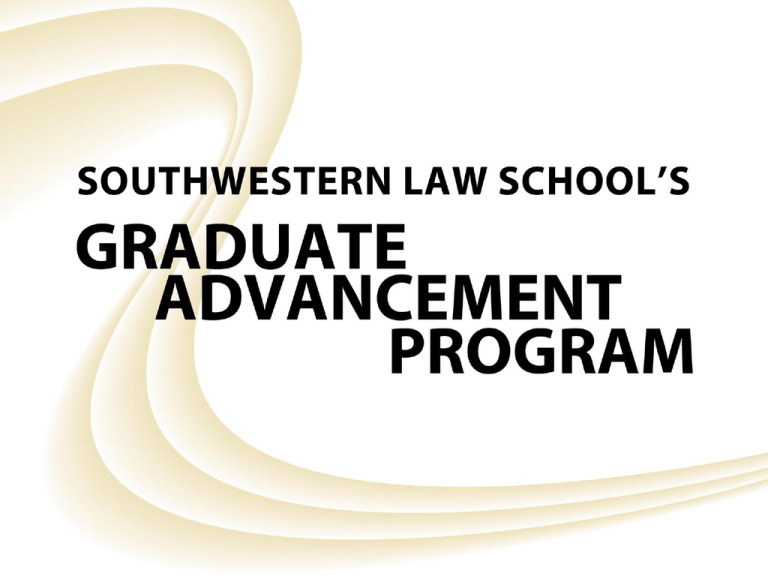
What Every New Attorney Needs to Know About Pretrial Practice The Life of a Civil Lawsuit From Pleadings to Discovery to Making Your First Court Appearance PART I: PLEADINGS Professor Steven P. Byrne ‘77 PART II: DISCOVERY & DISCOVERY MOTIONS Professor Don G. Forgey ’77 PART III: MAKING YOUR FIRST COURT APPEARANCE Professor Gary Geuss ’86 Pleadings Professor Steven P. Byrne ‘77 Byrne and Associates Civil Litigation in State Court Planning, Drafting and Filing Complaints and Responsive Pleadings 1. Plaintiff’s Case – A. Development of a Theme of the Case – What is your case about? 1) Consider available causes of action (see Appendix 1) a. What facts are favorable to each cause of action? b. What facts are unfavorable? 2) Is your theory supported by the law? a. Complete your legal research prior to preparing pleadings. b. Review authority that supports your opponent’s claim. c. Consider Jury instructions as a guide. d. Ethical/Professional responsibility. 3) Evidence in support of your case. a. Identify witnesses as soon as you can. b. Identify documents and other tangible evidence available. c. Identify evidentiary issues which could be problematic. (e.g. inadmissable or illegally obtained evidence) 4) Anticipate possible defenses to your client’s claim a. Evidence in support of each defense b. Can you do or say anything to defeat the defense? 5) Government Claim Action against public entity. Determine whether the claim is one for which a written claim must be presented to a public entity before maintaining action [Gov. Code 905-905.6, 945.4]. 6) Proper Court a. Jurisdiction i. Limited Jurisdiction Court. ii. Unlimited Jurisdiction. b. Venue - Proper court (location) in which to file. c. Court realignment in Los Angeles County i. All Personal injury cases are filed in Central or ii. Unlawful Detainer (evictions) in hub courts iii. Probate in Central 7) Who is your audience? a. Jury trial or a court trial. b. Do you need to humanize your client or dehumanize your opponent (Is your client an individual or a corporation - why this may matter) B. Preparation of the Complaint 1) Contents a. Capacity of plaintiff [CCP 367-377]. b. Residence (generally optional) [CC 1812.10, 2984.4; CCP 392-395.5]. c. Name, capacity, and residence of defendants [CC 1812.10, 2984.4; CCP 392-395.5]. d. Fictitious name allegations, if appropriate [see CCP 474]. e. Agency allegations, if appropriate. f. Other facts showing proper venue, if required [CCP 396a]. g. Facts constituting cause of action [CCP 425.10(a)]. h. Prayer for relief [CCP 425.10(b)]. i. Joinder of other causes of action of plaintiff or of co-plaintiffs with cause of action against defendant(s) [CCP 427.10(a)]. j. Joinder of parties. i. Permissive. a) Plaintiffs. [CCP 378(a)]. b) ii. Defendants.[CCP 379(a)]. Compulsory. a) Persons required as parties [CCP 389(a)]. b) Reluctant co-plaintiff [CCP 382]. 2. Drafting the Complaint. A. Mandatory format requirements [Cal. Rules of Ct. 201] B. Traditional (non-form pleading) C. Judicial Council Form Pleadings Attachments - Causes of Action 1) Contract 2) Personal Injury, Property Damage, Wrongful Death 3) Unlawful Detainer 3. Signing. The Complaint must be signed by the attorney of record. [CCP 128.7] 4. Verification. Not always required. By affidavit or declaration if verification is required or desired [CCP 2009, 2015.5]. Execution of verification [CCP 446]: A. Individual plaintiff B. Authorized officer if the plaintiff is not an individual. C. By Counsel if plaintiff is not in the county in which counsel has offices or is unable to verify it or when facts are within attorney's knowledge. 5. Additional documents required to be filed with the Complaint A. Summons - Judicial Council form is required. [Gov Code 68511; Cal. Rules of Ct 982]. Original for issuance by Court Clerk and copies to conform B. Civil Case Cover Sheet C. Addendum to Civil Case Cover Sheet D. Alternative Dispute Resolution (ADR) forms E. Certificate of merit [claim for professional negligence of architect, engineer, or land surveyor [CCP 411.35(a)]. F. Notice of Related Cases, if any. [Ca. Rules of Ct., Rule 804(a)] G. Cover sheets or other papers required by local court rule. 6. Copies of Pleadings. How many copies should you make? A. B. C. D. E. Original for filing. Copy for service on each defendant. Copy for office file. Copy for client Additional copies as desired. 7. Filing Complaint Most lawyers use an Attorney Service. A. Select the court with proper venue and subject matter jurisdiction. See Section 1A(6) above. B. Deliver Summons, Complaint and related papers to court clerk filing window Fax filing, Electronic Filing C. Pay filing fee [Gov. Code 26820.4, 26820.6] 8. Service on Defendants– Most lawyers use a Registered process server with an attorney service or the County Sheriff. A. Have a conformed copy of the summons served on each defendant, together with a copy of the complaint and all other documents [CCP 413.10- 416.70]. B. Proof of Service. The person who served the pleadings must prepare and file a separate declaration of service for each defendant [CCP 417.10 et seq.] C. A Party to the action may not serve the pleadings. 9. Default – If a defendant fails to respond in a timely manner. A. Request for entry of default. [CCP 585]. B. Declarations in support of entry of judgment [CCP 585]. 2. Defendant’s Case – A. Development of a theme to counter Plaintiff’s theme. 1) Review the claims asserted a. What facts support each cause of action? b. What facts are unfavorable? 2) Is your theory (i.e. defense) supported by the law? a. Complete your legal research prior to preparing pleadings b. Review authority that supports your opponent's claim c. Consult Jury instructions as a guide 3) Evidence in support of your case a. Identify witnesses as soon as you can b. Identify documents and other tangible evidence available c. Identify evidentiary issues which could be problematic 4) Evaluate the possible defenses your client has to the claim a. Evidence in support of each defense b. Can the Plaintiff do or say anything to defeat that defense 5) Government Claim Action against public entity. Determine whether the claim is one for which a written claim must be presented to a public entity before maintaining action [Gov. Code 905 905.6, 945.4]. 6) Improper Court a. Jurisdiction i. Limited Jurisdiction Court ii. Unlimited Jurisdiction b. Venue - inconvenient forum [CCP 396, 397] 7) Delay in prosecution a. Statutes of Limitations b. Failure to serve in a timely manner [CCP 583 et sec] 8) Who is your audience? a. Jury trial or a court trial. b. Do you need to humanize your client or dehumanize your opponent (is your client an individual or a corporation - why this may matter) B. Defendant’s Initial Pleadings 1) Answer a. Traditional format or Judicial Council form pleading Judicial Council i. Contract ii. Personal Injury, Property Damage, Wrongful Death iii. Unlawful Detainer b. Affirmative Defenses (Appendix 2) c. Prayer for Relief 2) Demurrer - Defect in Complaint a. Lack of subject matter jurisdiction [CCP 430.10(a)] b. Failure to state sufficient facts [CCP 430.10(e)] c. Uncertain pleading [CCP 430.10(f)] d. Other grounds 3) Motion to Strike [CCP 435 - 437] 4) Motion to transfer to proper court [CCP 396b] 5) Petition to Compel Arbitration [CCP 1281.2] 6) Cross-Complaint (State) or Counter Claim (Fed) a. Compulsory [CCP 426.30(a)] b. Permissive c. Third Party Claims (Indemnification, Contribution) Class Exercise • You are a new Associate in a large law firm that has a substantial insurance defense practice. You have received a Memorandum from a supervising attorney to consider the materials available and prepare an initial response to a Complaint. • Consider and discuss the legal issues, as well as the political and business ramifications of your response.

